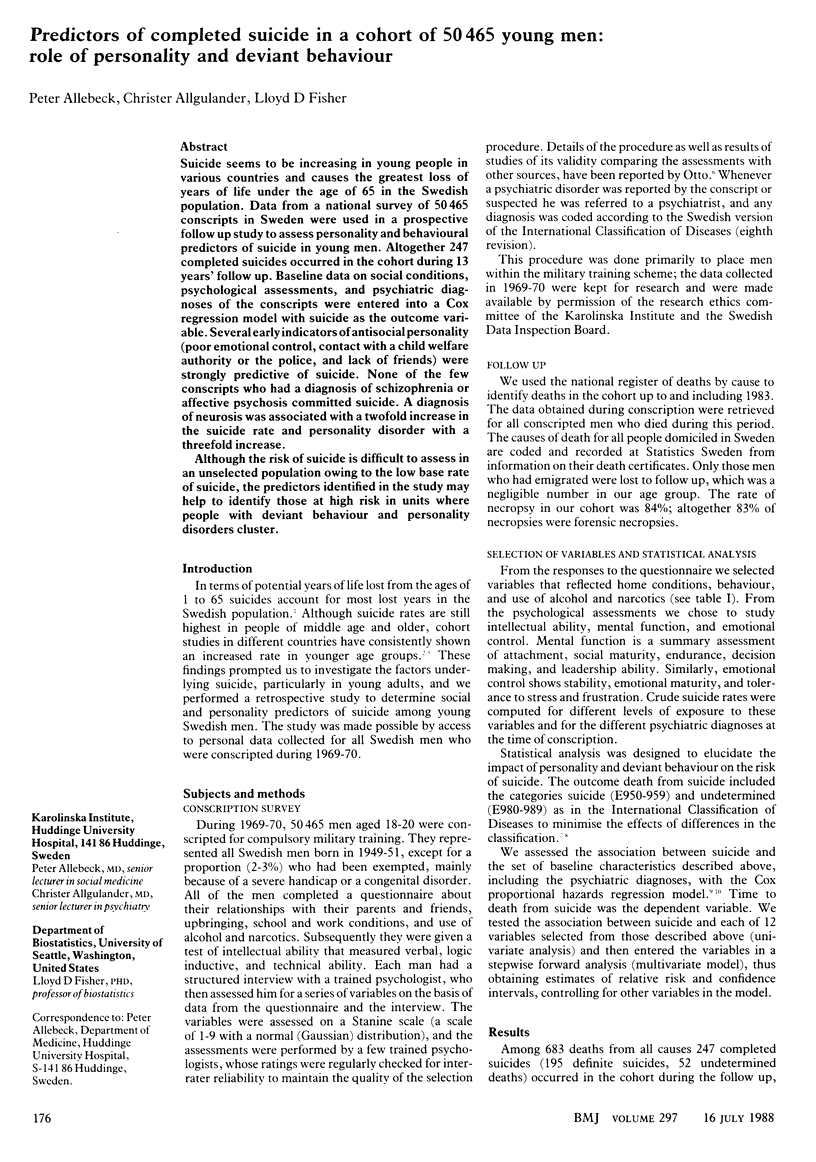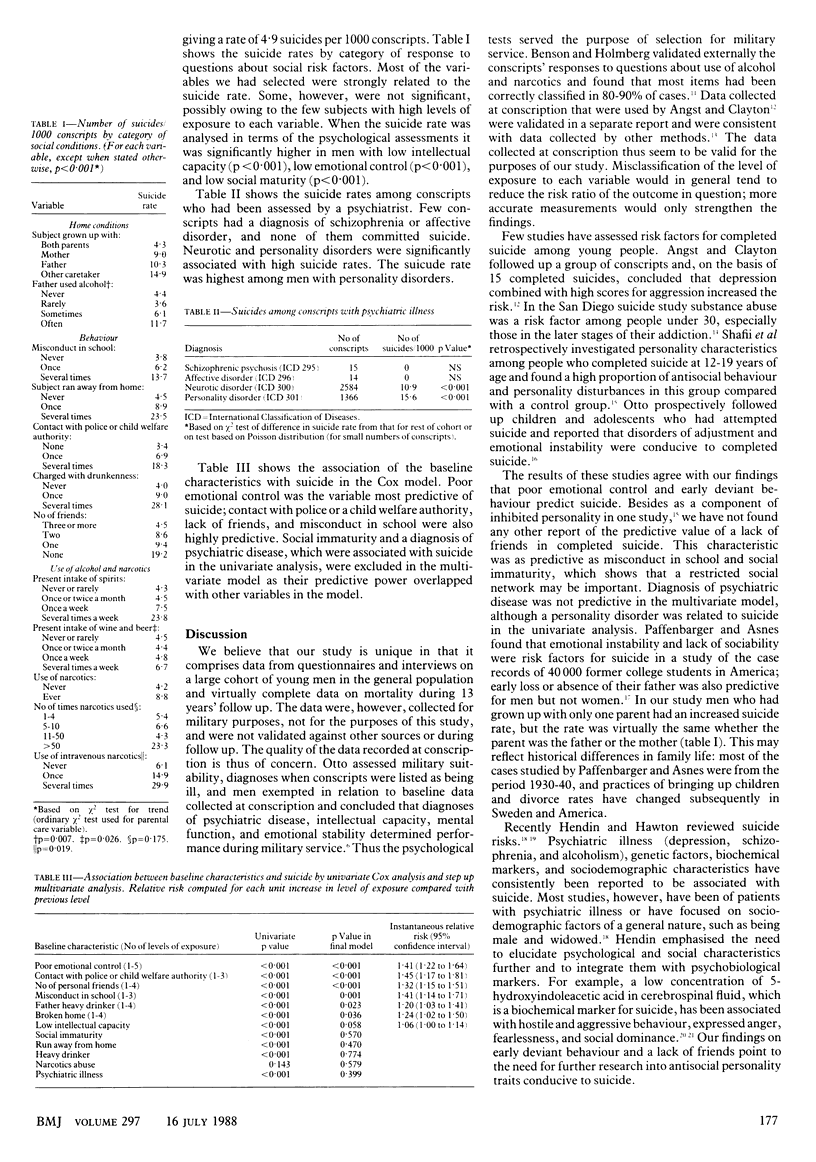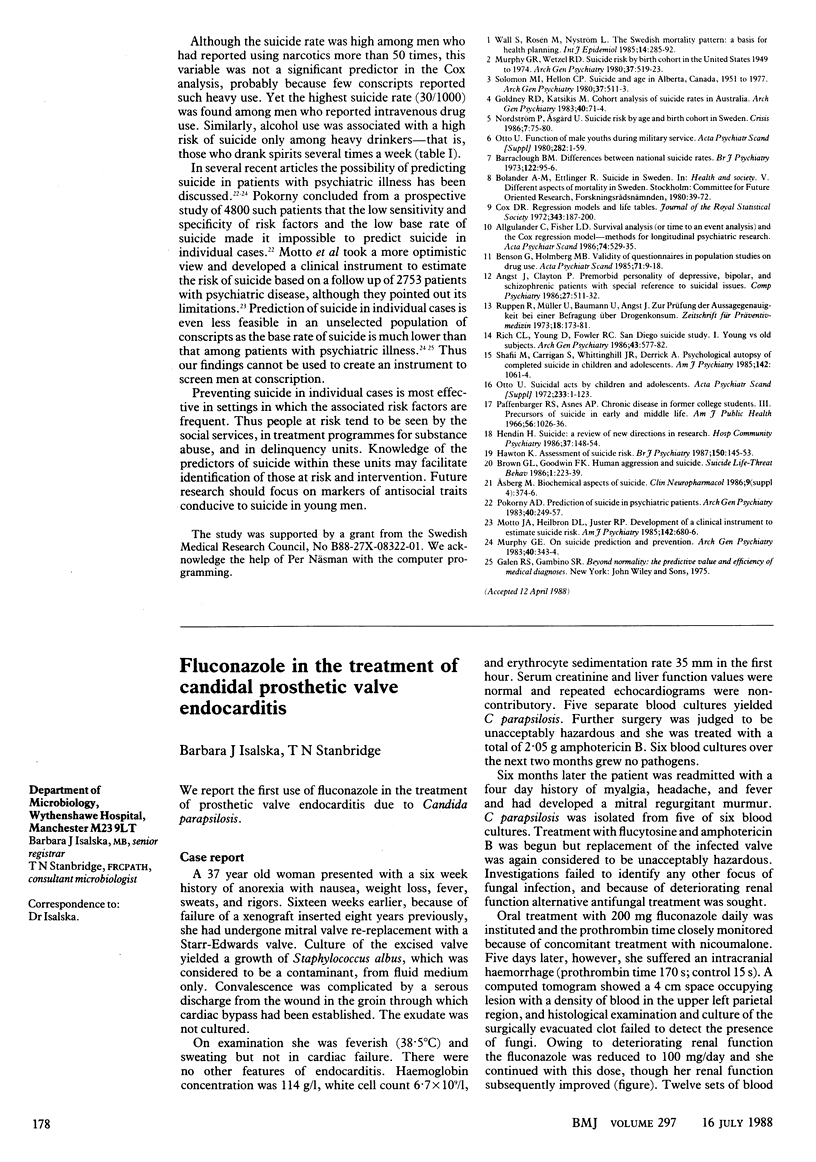Abstract
Suicide seems to be increasing in young people in various countries and causes the greatest loss of years of life under the age of 65 in the Swedish population. Data from a national survey of 50,465 conscripts in Sweden were used in a prospective follow up study to assess personality and behavioural predictors of suicide in young men. Altogether 247 completed suicides occurred in the cohort during 13 years' follow up. Baseline data on social conditions, psychological assessments, and psychiatric diagnoses of the conscripts were entered into a Cox regression model with suicide as the outcome variable. Several early indicators of antisocial personality (poor emotional control, contact with a child welfare authority or the police, and lack of friends) were strongly predictive of suicide. None of the few conscripts who had a diagnosis of schizophrenia or affective psychosis committed suicide. A diagnosis of neurosis was associated with a twofold increase in the suicide rate and personality disorder with a threefold increase. Although the risk of suicide is difficult to assess in an unselected population owing to the low base rate of suicide, the predictors identified in the study may help to identify those at high risk in units where people with deviant behaviour and personality disorders cluster.
Full text
PDF


Selected References
These references are in PubMed. This may not be the complete list of references from this article.
- Allgulander C., Fisher L. D. Survival analysis (or time to an event analysis), and the Cox regression model--methods for longitudinal psychiatric research. Acta Psychiatr Scand. 1986 Dec;74(6):529–535. doi: 10.1111/j.1600-0447.1986.tb06279.x. [DOI] [PubMed] [Google Scholar]
- Angst J., Clayton P. Premorbid personality of depressive, bipolar, and schizophrenic patients with special reference to suicidal issues. Compr Psychiatry. 1986 Nov-Dec;27(6):511–532. doi: 10.1016/0010-440x(86)90055-6. [DOI] [PubMed] [Google Scholar]
- Asberg M. Biochemical aspects of suicide. Clin Neuropharmacol. 1986;9 (Suppl 4):374–376. [PubMed] [Google Scholar]
- Benson G., Holmberg M. B. Validity of questionnaires in population studies on drug use. Acta Psychiatr Scand. 1985 Jan;71(1):9–18. doi: 10.1111/j.1600-0447.1985.tb05045.x. [DOI] [PubMed] [Google Scholar]
- Brown G. L., Goodwin F. K. Human aggression and suicide. Suicide Life Threat Behav. 1986 Summer;16(2):223–243. doi: 10.1111/j.1943-278x.1986.tb00353.x. [DOI] [PubMed] [Google Scholar]
- Goldney R. D., Katsikitis M. Cohort analysis of suicide rates in Australia. Arch Gen Psychiatry. 1983 Jan;40(1):71–74. doi: 10.1001/archpsyc.1983.01790010073009. [DOI] [PubMed] [Google Scholar]
- Hawton K. Assessment of suicide risk. Br J Psychiatry. 1987 Feb;150:145–153. doi: 10.1192/bjp.150.2.145. [DOI] [PubMed] [Google Scholar]
- Hendin H. Suicide: a review of new directions in research. Hosp Community Psychiatry. 1986 Feb;37(2):148–154. doi: 10.1176/ps.37.2.148. [DOI] [PubMed] [Google Scholar]
- Motto J. A., Heilbron D. C., Juster R. P. Development of a clinical instrument to estimate suicide risk. Am J Psychiatry. 1985 Jun;142(6):680–686. doi: 10.1176/ajp.142.6.680. [DOI] [PubMed] [Google Scholar]
- Murphy G. E. On suicide prediction and prevention. Arch Gen Psychiatry. 1983 Mar;40(3):343–344. doi: 10.1001/archpsyc.1983.01790030113015. [DOI] [PubMed] [Google Scholar]
- Murphy G. E., Wetzel R. D. Suicide risk by birth cohort in the United States, 1949 to 1974. Arch Gen Psychiatry. 1980 May;37(5):519–523. doi: 10.1001/archpsyc.1980.01780180033003. [DOI] [PubMed] [Google Scholar]
- Nordström P., Asgård U. Suicide risk by age and birth cohort in Sweden. Crisis. 1986 Sep;7(2):75–80. [PubMed] [Google Scholar]
- Otto U. Suicidal acts by children and adolescents. A follow-up study. Acta Psychiatr Scand Suppl. 1972;233:7–123. [PubMed] [Google Scholar]
- Paffenbarger R. S., Jr, Asnes D. P. Chronic disease in former college students. 3. Precursors of suicide in early and middle life. Am J Public Health Nations Health. 1966 Jul;56(7):1026–1036. doi: 10.2105/ajph.56.7.1026. [DOI] [PMC free article] [PubMed] [Google Scholar]
- Pokorny A. D. Prediction of suicide in psychiatric patients. Report of a prospective study. Arch Gen Psychiatry. 1983 Mar;40(3):249–257. doi: 10.1001/archpsyc.1983.01790030019002. [DOI] [PubMed] [Google Scholar]
- Rich C. L., Young D., Fowler R. C. San Diego suicide study. I. Young vs old subjects. Arch Gen Psychiatry. 1986 Jun;43(6):577–582. doi: 10.1001/archpsyc.1986.01800060071009. [DOI] [PubMed] [Google Scholar]
- Shafii M., Carrigan S., Whittinghill J. R., Derrick A. Psychological autopsy of completed suicide in children and adolescents. Am J Psychiatry. 1985 Sep;142(9):1061–1064. doi: 10.1176/ajp.142.9.1061. [DOI] [PubMed] [Google Scholar]
- Solomon M. I., Hellon C. P. Suicide and age in Alberta, Canada, 1951 to 1977. A cohort analysis. Arch Gen Psychiatry. 1980 May;37(5):511–513. doi: 10.1001/archpsyc.1980.01780180025002. [DOI] [PubMed] [Google Scholar]
- Wall S., Rosén M., Nyström L. The Swedish mortality pattern: a basis for health planning? Int J Epidemiol. 1985 Jun;14(2):285–292. doi: 10.1093/ije/14.2.285. [DOI] [PubMed] [Google Scholar]


